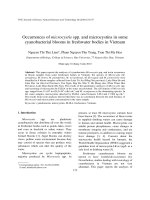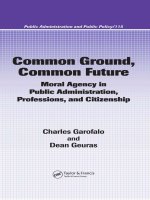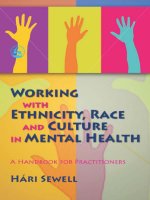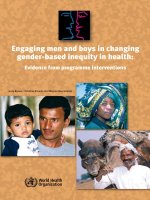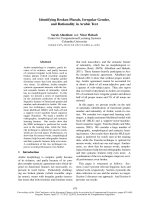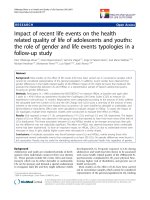Projecting 911 race gender and citizenship in recent hollywood films
Bạn đang xem bản rút gọn của tài liệu. Xem và tải ngay bản đầy đủ của tài liệu tại đây (1.35 MB, 203 trang )
free ebooks ==> www.ebook777.com
www.ebook777.com
free ebooks ==> www.ebook777.com
free ebooks ==> www.ebook777.com
Projecting 9/11
www.ebook777.com
free ebooks ==> www.ebook777.com
Perspectives on a Multiracial America Series
Joe R. Feagin, Texas A&M University,
Series Editor
Melanie Bush, Breaking the Code of Good Intentions: Everyday Forms of Whiteness
Amir Mavasti and Karyn McKinney, Middle Eastern Lives in America
Katheryn Russell-Brown, Protecting Our Own: Race, Crime, and African Americans
Victoria Kaplan, Structural Inequality: Black Architects in the United States
Elizabeth M. Aranda, Emotional Bridges to Puerto Rico: Migration, Return Migration,
and the Struggles of Incorporation
Richard Rees, Shades of Difference: A History of Ethnicity in America
Pamela Anne Quiroz, Adoption in a Color-Blind Society
Adia Harvey Wingfield, Doing Business with Beauty: Black Women, Hair Salons, and the
Racial Enclave Economy
Angela J. Hattery, David G. Embrick, and Earl Smith, Globalization and America: Race,
Human Rights, and Inequality
Erica Chito Childs, Fade to Black and White: Interracial Images in Popular Culture
Jessie Daniels, Cyber Racism: White Supremacy Online and the New Attack on Civil
Rights
Teun A. van Dijk, Racism and Discourse in Latin America
C. Richard King, Carmen R. Lugo-Lugo, and Mary K. Bloodsworth-Lugo, Animating
Difference: Race, Gender, and Sexuality in Contemporary Films for Children
Melanie E. L. Bush, Everyday Forms of Whiteness: Understanding Race in a “PostRacial” World, 2nd edition
David J. Leonard and C. Richard King, Commodified and Criminalized: New Racism and
African Americans in Contemporary Sports
Maria Chávez, Everyday Injustice: Latino Professionals and Racism
Benjamin Fleury-Steiner, Disposable Heroes: The Betrayal of African American Veterans
Noel A. Cazenave, The Urban Racial State: Managing Race Relations in American Cities
Cherise A. Harris, The Cosby Cohort: Race, Class, and Identity among Second Generation Middle Class Blacks
Louwanda Evans, Cabin Pressure: African American Pilots, Flight Attendants, and Emotional Labor
Kristen M. Lavelle, Whitewashing the South: White Memories of Segregation and Civil
Rights
Ruth Thompson-Miller, Joe R. Feagin, and Leslie H. Picca, Jim Crow’s Legacy: The
Lasting Impact of Segregation
Mary K. Bloodsworth-Lugo and Carmen R. Lugo-Lugo, Projecting 9/11: Race, Gender,
and Citizenship in Recent Hollywood Films
free ebooks ==> www.ebook777.com
Projecting 9/11
Race, Gender, and Citizenship in
Recent Hollywood Films
Mary K. Bloodsworth-Lugo and
Carmen R. Lugo-Lugo
ROWMAN & LITTLEFIELD
Lanham • Boulder • New York • London
www.ebook777.com
free ebooks ==> www.ebook777.com
Published by Rowman & Littlefield
A wholly owned subsidiary of The Rowman & Littlefield Publishing Group, Inc.
4501 Forbes Boulevard, Suite 200, Lanham, Maryland 20706
www.rowman.com
Unit A, Whitacre Mews, 26–34 Stannery Street, London SE11 4AB, United Kingdom
Copyright © 2015 by Rowman & Littlefield
All rights reserved. No part of this book may be reproduced in any form or by any
electronic or mechanical means, including information storage and retrieval systems,
without written permission from the publisher, except by a reviewer who may quote
passages in a review.
British Library Cataloguing in Publication Information Available
Library of Congress Cataloging-in-Publication Data
Bloodsworth-Lugo, Mary K.
Projecting 9/11 : race, gender, and citizenship in recent Hollywood films / Mary K. BloodsworthLugo and Carmen R. Lugo-Lugo.
pages cm — (Perspectives on a multiracial America series)
Includes bibliographical references and index.
ISBN 978-1-4422-1826-0 (cloth : alk. paper) — ISBN 978-1-4422-1828-4 (electronic)
1. September 11 Terrorist Attacks, 2001, in motion pictures. 2. Race in motion pictures. 3. Sex role in
motion pictures. 4. Citizenship in motion pictures. 5. Motion pictures—United States—History—
21st century. I. Lugo-Lugo, Carmen R. II. Title.
PN1995.9.T46B58 2014
791.43'6552—dc23
2014030141
TM
The paper used in this publication meets the minimum requirements of American
National Standard for Information Sciences Permanence of Paper for Printed Library
Materials, ANSI/NISO Z39.48-1992.
Printed in the United States of America
free ebooks ==> www.ebook777.com
Contents
Acknowledgments
vii
1 Introduction
1
2 White Masculinity and the (In)Security of 9/11
25
3 War and Sexualized/Racialized Threats
47
4 Narratives of Threat and 9/11 Monsters
69
5 9/11 Transnationalism and Gendered Citizenship
89
6 Animated 9/11 Raciality and Conceptions of Progress
109
7 The Great Recession and White Masculine (In)Security
Again
133
8 9/11 End-of-Days Hollywood
157
Bibliography
177
Filmography
187
Index
189
About the Authors
193
v
www.ebook777.com
free ebooks ==> www.ebook777.com
free ebooks ==> www.ebook777.com
Acknowledgments
This project is the outgrowth of a decade of work on the discourse
surrounding the events of September 11, 2001, especially rhetorical
techniques deployed by the G. W. Bush administration in response
to the happenings of that day. Official presidential discourse was
advanced and promoted in print media, television news, and
films—including Hollywood productions—to frame the events of
September 11, 2001, for an American public. This includes anxieties, fears, and insecurities of Americans in the wake of unprecedented events. The ideologies developed in the aftermath of September 11, 2001, form a 9/11 project, whereby “9/11” evokes much
more than happenings of a particular day. Rather, 9/11 issues an
array of meanings and significances—not the least of which are
those related to perceptions and conceptions of race, gender, and
citizenship in a new and changed America.
We would like to thank Joe R. Feagin, series editor for Perspectives on a Multiracial America, for his sincere interest in this project and for including it within his impressive series. We also appreciate the helpful and constructive feedback of Professor Feagin,
as well as anonymous peer reviewers, which helped to improve the
manuscript. We are very grateful to Sarah Stanton, senior acquisitions editor at Rowman & Littlefield, for encouraging a monograph
vii
www.ebook777.com
free ebooks ==> www.ebook777.com
viii
Acknowledgments
on these themes, and for her consistent generosity and assistance at
all stages of development and completion. Mary would like to
thank Selena K. L. Breikss for providing course assistance during
fall 2013 which facilitated the book’s completion. We are also
grateful to our colleagues in the Department of Critical Culture,
Gender, and Race Studies at Washington State University, especially Rich King, Lisa Guerrero, and David Leonard, for their ongoing and consistent support and friendship.
free ebooks ==> www.ebook777.com
Chapter One
Introduction
We learn about the world and how the world is run through the
mass media and popular culture. (Birkenstein, Froula, and Randell 2010, 11)
But what might be most culturally significant—and most affecting in so many ways—is exactly in what manner and to what
degree “9/11” is becoming our cultural esperanto: our language
of grief and anger, of loss and steadfastness. (Melnick 2009, 7)
In a Gallup poll conducted during the first quarter of 2010,
Americans identified terrorism, along with federal government
spending, as the most important threat faced by the United States.
Of respondents, 79 percent indicated that terrorism was an extremely or a very serious threat to the country (Saad 2010). Later that
same year, a USA Today/Gallup poll revealed that, for Americans,
Republicans in Congress would do a better job than Democrats’
handling seven of nine key election issues. The first issue listed was
terrorism, with the strongest support for Republicans at 55 percent.
The other six issues were immigration, federal spending, the economy, the situation in Afghanistan, jobs, and corruption in government (Jones 2010). It is worth noting that three of the seven issues
(terrorism, the situation in Afghanistan, and immigration) are issues directly connected to the events of September 11, 2001.
1
www.ebook777.com
free ebooks ==> www.ebook777.com
2
Chapter 1
This polling marked a departure from previous polling conducted since September 11, 2001, that consistently showed
Americans considered Democrats to be more likely to handle most
of these issues more effectively than Republicans (Jones 2010).
The one solid exception concerned terrorism, which from May
2002 to August 2010 showed Americans consistently trusted Republicans over Democrats, with the exception of one poll conducted during October 2006 (Gallup 2013). In addition to the confidence in Republicans reflected by the 2010 USA Today /Gallup
poll, the same poll showed that 75 percent of respondents identified
terrorism as an extremely or very important issue when voting for
congressional members that year.
The fact that nine years after the events of September 11, 2001,
terrorism and related issues occupied such a prominent position in
the collective mind of Americans, along with the consistent support
for Republicans in Congress to handle this particular issue, reflects
a totalizing rhetorical, ideological, and sociopolitical pattern (or
project) emerging after the events of that day. We argue elsewhere
that the G. W. Bush administration identified, constructed, and controlled threats to the country by attempting to “contain threatening
bodies in ‘new’ and ‘old’ ways” (Bloodsworth-Lugo and LugoLugo 2010, xiii). In this book, we name this particular effort the 9/
11 project , and in this introduction, we articulate the main features
of the 9/11 project and analyze its primary workings. We then aim
to show how Hollywood feature films released after September 11,
2001, encapsulate and depict the 9/11 project . As we explain below, mainstream feature films are direct products and reflections of
the cultural moment in which they are created and thereby hold key
insights about these very moments.
free ebooks ==> www.ebook777.com
Introduction
3
ARTICULATING THE 9/11 PROJECT
When we refer to the 9/11 project, we take into account the fact
that since September 11, 2001, “9/11” has emerged as two related
yet distinct notions: a historical marker recalling the horrific happenings of a particular day in U.S. history, and an institutionalized
ideological, philosophical, and sociological construct encompassing more than a day and its particular events. As such a construct,
we might say that “9/11” marks a multifaceted sociopolitical project involving the handling and containment of terrorism in particular and threats more generally. This project has involved the following enumerated efforts:
1. The creation of key governmental institutions and policies
aimed at managing and containing perceived threats to
the United States and its people with a decidedly global
reach. These have included the Department of Homeland
Security and the USA Patriot Act.
2. Three war efforts. One of these has been global and amorphous in scope (the War on Terror), while the other two (the
wars in Afghanistan and Iraq) have been localized with global repercussions.
3. Specific militarized sites in the United States and around
the globe associated with the housing and management of
terrorist and/or threatening bodies. These have included
the Guantanamo Bay detention camp, Abu Ghraib prison, and
U.S. I.C.E. detention centers.
4. Renewed nativist efforts at the federal and state levels
seeking to restrict those deemed “un-American” from entering U.S. borders. These have included the building of a
fence separating the United States–Mexico international border, the deployment of military personnel to the United
States–Mexico border, and Arizona’s SB 1070.
www.ebook777.com
free ebooks ==> www.ebook777.com
4
Chapter 1
5. A paradigm shift in air travel. This shift has included
changes in screening and security, who is allowed at the
gates, a revamping of the Transportation Security Administration (TSA) and its placement under the Department of
Homeland Security, and changes in what can be carried onto
airplanes by passengers.
6. A consistent governmental rhetoric justifying items 1–5
on this list and creating an ideology around threats to the
security of the country.
The first five features constitute the political infrastructure of the 9/
11 project—an infrastructure designed with a global reach to ostensibly safeguard the local American population, while the sixth feature ascertains its sociocultural component. Together, they have
become an omnipresent entity in U.S. society after September 11,
2001.
As part of its sixth feature, the 9/11 project has included the
development of ideologies, fears, anxieties, and perceptions—what
Jeffrey Melnick (2009) has termed a “9/11 sensibility.” It is 9/11 as
a value-laden project of social and cultural import that drives the
analytical pursuits of this book. Due to the durability and scope of
these features, the ideological and sociopolitical project that is 9/11
has been revealed as having long-term impacts on Americans and
their perceptions of threats, security, and even Americanness. From
this perspective, 9/11 has been developed and engineered. As such,
we argue that 9/11 was not present on, but rather emerged from, the
events of September 11, 2001. Thus, to be clear and to differentiate
the date of such events from the 9/11 project as a broader construct,
we use the full date (September 11, 2001) when we mean to reference the day or a historical moment, and we use 9/11 when we aim
to discuss the sociopolitical and ideological project described
above. We also use 9/11 as a descriptor (for example, 9/11 film and
9/11 society), and we use 9/11 instead of post-9/11 to emphasize
that the 9/11 project is still alive, relevant, and present tense.
free ebooks ==> www.ebook777.com
Introduction
5
An important component of the 9/11 project is its effect on
every aspect of U.S. culture and society, including cultural production. In his book 9/11 Culture, Melnick proposes that as an event
transformed into a concept, a discourse, and a language, 9/11 has
served “as the answer to countless questions of social import,”
suggesting that 9/11 can be deployed to analyze and understand
cultural and material production after September 11, 2001 (2009,
3). In The Selling of 9/11, Dana Heller tackles the material production of 9/11, arguing that September 11, 2001, was transformed
“into a commercial pitch, a slogan” (2005, 2). Espousing a similar
view to Melnick’s idea of 9/11 as a material production, Heller
states, “In the weeks and months following 9/11, the market for
goods representing American patriotic unity and pride expanded
dramatically” (6).
While these and other scholars consider ways in which September 11, 2001, has affected American culture, politics, society, and
entertainment post-2001 (that is, ways in which 9/11 has emerged),
we press this thesis to propose that the 9/11 project has infected our
collective imagination so thoroughly that it has become a primary
lens through which Americans view the world around them. As
with any other lens, the 9/11 lens is rooted in history, and as such, it
can interact and even work in tandem with other lenses. In this
case, we would specifically like to connect the 9/11 project to Joe
Feagin’s white racial frame, which as he conveys, has been crafted
over centuries of systemic racism and “extreme racial oppression”
(2010, 2).
LINKING THE 9/11 PROJECT TO THE
WHITE RACIAL FRAME
According to Feagin, the white racial frame is a dominant frame
with “an overarching white worldview that encompasses a broad
and persisting set of racial stereotypes, prejudices, ideologies, im-
www.ebook777.com
free ebooks ==> www.ebook777.com
6
Chapter 1
ages, interpretations and narratives, emotions, and reactions to language accents, as well as racialized inclinations to discriminate”
(2010, 3). Feagin is clear that the white racial frame has global
implications for our contemporary world racial order, a very important point, given the global reach of the 9/11 project. Adia Harvey
Wingfield furthers the analysis of systemic racism by offering the
concept of “systemic gendered racism,” explaining that manifestations of systemic racism are necessarily gendered, producing different outcomes for men and women of color (2009, 7). In particular,
she argues that “inasmuch as racial oppression is continuing and
fundamental in U.S. society, the ‘racial dimensions’ like racist
ideology, racist imagery, and racist institutions that allow systemic
racism to flourish are gendered” (7).
We agree with Wingfield that gender mediates systemic racism
and would like to add that certain historical events are so powerful
in their impact that they also mediate, if for a specific time, the
racial and gendered dimensions allowing systemic racism to flourish. With such an impactful event, the white racial frame retains its
main characteristics, but these also acquire specific inflections, especially when the event is transformed into a social project. We
maintain that this is the case with 9/11 (event + project), through
which systemic and gendered racism, and more specifically the
white racial frame, have acquired particular emphases. Thus, we
have modified the features identified by Feagin as belonging to the
white racial frame in order to identify the 9/11 inflections to contemporary expressions of systemic gendered racism:
1. Nonwhite bodies as terrorist threats. After September 11,
2001, nonwhite groups in general and specific racialized
groups such as Middle Easterners and Latinos have been depicted as suspicious and threatening to Americanness, which
is rendered white. Members of these groups have been rendered destroyers of civilization and democracy.
free ebooks ==> www.ebook777.com
Introduction
7
2. Consistent racial narratives about terrorism and terrorist
bodies. Terrorists have been said to “lurk in shadows” and
“cross unprotected borders.” Such narratives serve to justify
the specific racialization of groups as threatening, presenting
them as backward and animal-like (residing in caves, as rats
in need of being “smoked out”), while simultaneously positioning U.S. society as a democracy seeking progress. Within
this construct, progress is seen as an imperative of U.S. society. In turn, the United States is considered the ultimate purveyor of democracy (“the leader of the free world”) in direct
juxtaposition to backward countries that “harbor terrorists.”
3. Images and accents about racialized and threatening bodies as terrorist bodies. These include photos released from
Abu Ghraib, images from prisoners in Guantanamo, and language such as “enemy combatant” and “illegal immigrant.”
Images and accents help to create a specific discourse, reinforcing ideas about specific groups as threatening while reifying the whiteness of Americanness.
4. Emotions and feelings toward brown bodies. This point is
best illustrated by the language of pundits and social commentators in relation to perceived terrorist, nonwhite, and/or
immigrants bodies. This language creates emotional reactions
to certain groups while reinforcing ideas developed by the
previous features. In this process, singled-out groups are given a specific tone of threatening otherness by discourse and
ideology. We discuss elsewhere how this process “has capitalized on United States fears and anxieties about public and
national safety. Those located outside of United States’ borders of security and comfort have been ‘browned,’ reinforcing fears and insecurities around them” (Bloodsworth-Lugo
and Lugo-Lugo 2010, 73).
5. Inclinations to discriminatory actions by individuals and
institutions. These include desecration of mosques, beatings
www.ebook777.com
free ebooks ==> www.ebook777.com
8
Chapter 1
and harassment of suspected Middle Eastern men and women, the targeted suspension of civil liberties by the USA Patriot Act, and the “reasonable suspicion” clause in Arizona’s SB
1070. These actions are justified, and sometimes even demanded, by the ideologies created via this process.
To Feagin’s white racial frame, we would like to add a
feature with a prominent role within the 9/11 project. While
implied within Feagin’s framework, its prominence for our
discussion in this book warrants a separate heading:
6. The conflation of white and American. Although not a new
conflation, within 9/11 U.S. society, a terrorist threat to
Americanness is a terrorist threat to whiteness. This conflation makes it easier to establish and justify an “us versus
them” rhetorical strategy and even easier to distinguish between “browned” bodies and “Americans.”
Finally, we argue that, as with the white racial frame, the 9/11
project has a strong global component, in which, to reiterate, these
features do not replace but rather work in tandem with the features
of the original frame. Due to its lasting impact, we can locate the
social and political project that is 9/11 (that is, the ideological and
sociocultural concept developed as a response to the September 11,
2001, events) in most cultural artifacts produced after that date.
These include U.S. mainstream films. In fact, as two-hour time
capsules of our ideologies, Hollywood films produced after September 11, 2001, tend to feature the elements of the 9/11 project
described above—infrastructure and ideologies alike.
FILMS AFTER SEPTEMBER 11, 2001, AND
THE 9/11 PROJECT
In our view, many films released after September 11, 2001, have
brilliantly embodied and advanced the 9/11 project. A prominent
aspect of this project is a rhetoric of “us versus them,” involving
free ebooks ==> www.ebook777.com
Introduction
9
multifaceted components promoted during the G. W. Bush presidency. Through articulations of terrorism and threat as “them”
marking a threat to “us,” President Bush discussed an axis of evil
versus a coalition of the willing. He emphasized that a democratic
society moves forward and embraces progress, whereas terrorist
cells, training camps, and countries that “harbor terrorists” recall an
undemocratic past. The Bush administration consistently reminded
the American public that terrorism, terror, and terrorists (“them”)
are never far from Americans (“us”).
In fact, if we review the four State of the Union addresses President Bush gave after his reelection in 2004, we find that he used the
word “terrorist(s)” a total of fifty-seven times and “terror” a total of
fifty-four times (for an average of thirteen to fourteen times per
speech) (Presidential Rhetoric.com 2013). This rhetoric served to
construct and reinforce the borders and boundaries between the
categories “American” and “un-American”—categories that, since
then, have invoked the nation but have likewise promoted gendered, racial(ized), and sexual(ized) notions. In a 9/11 United
States, and through the 9/11 project, protection, security, and the
containment of threats have combined with matters of gender, race,
and citizenship to become ideological tools for Americans’ understanding of themselves and those around them. In 9/11 Hollywood
films, we find both an examination of the events of September 11,
2001, and the operation of the ideological processes that have
shaped the perceptions of Americans in a 9/11 world. As sources of
meaning and influential carriers of reality, films have fostered the
construction and comprehension of the 9/11 project and 9/11
American culture.
Before we continue with our discussion of film, we should explain the naming for this group of films and how we have approached our selection and analysis. First, we refer to these films as
9/11 films, as opposed to post-9/11 films, not because these are
films that depict the events of September 11, 2001, (although some
www.ebook777.com
free ebooks ==> www.ebook777.com
10
Chapter 1
do), but rather because these films reflect the 9/11 project as explained above. Second, we have chosen to discuss films that in our
estimation depict the 9/11 project with the understanding that these
are not the only films that depict that project, and in fact we maintain that a vast number of films might be construed as 9/11 films.
Indeed, within some frameworks, all films released after September
11, 2001, might be considered such films. The films we have selected might also depict other projects, sensibilities, and frameworks, while at the same time, other films produced after September 11, 2001, might not depict the 9/11 project as discussed in this
book. These possibilities do not preclude the films analyzed here
from being 9/11 films. It is not our intention to provide an exhaustive representation of what we call 9/11 films nor is it our intention
to deny other lenses and frameworks. The films discussed in this
book were chosen because each depicts a specific aspect of the 9/11
project.
Mainly, we concentrate on the messages rehearsed by each of
these films and the lessons delivered to viewers, regardless of
whether or how these messages are received. Thus, we are not
concerned with how many people viewed these films, or with how
much critics liked or appreciated them, or with the amount of box
office revenue they received. Rather, we are concerned with the
tropes projected by the films, the ideas put forth, and the ideologies
recreated. We also assume that the writers, producers, and directors
creating these films are part and parcel of the society and time
period in which they live. Some of the films we discuss here are
about the events of September 11, 2001. Others depict the infrastructure of the 9/11 project, including its wars. Others still are
about futuristic scenarios and places invented by the Hollywood
imagination, which at first glance, appear to have nothing to do
with the events of September 11, 2001. However, as we demonstrate in our discussion, the messages in these films are inextricably
tied to the 9/11 project. In the end, we propose that our analysis in
free ebooks ==> www.ebook777.com
Introduction
11
this book could be extended to other films, and to cultural productions more generally, released after September 11, 2001.
RACIALIZED GROUPS IN U.S. MAINSTREAM FILMS
In his seminal text Film as Social Practice, Graeme Turner asserts,
“The reason we want to examine film at all is because it is a source
of pleasure and significance [that is, meaning] for so many in our
culture” (2006, 61). Jaap van Ginneken goes further by arguing that
along with other genres of popular culture (such as television and
music), films present a “forceful substitute [of] reality,” for
“sounds and images about other times and places convince us much
more easily that this is how it probably is or was” (2007, 2–3).
While we might wish to agree with van Ginneken’s insight, we
would argue that instead of being forceful substitutes for reality,
films offer powerful ideological representations at a given time
based on cultural perceptions of reality. Thus, it is not simply a
matter of “this is how it probably is or was” but of “this is how ‘we’
perceive(d) it to be.” As in any other context, perception thereby
becomes reality. As sources of meaning and potentially influential
perceptions of reality, films hold a key to comprehending the culture and time in which they are created. Andrew Schopp and Matthew B. Hill provide insight in relation to film (or popular culture
more broadly) and perceptions after September 11, 2001, when
they point out that “the events of September 11 and the subsequent
War on Terror have further tangled the knotted relationship between popular culture, political discourse, and terrorism” (2009,
12).
In this book, we engage with ideologies and understandings developed as part of the 9/11 project and ways in which those ideologies and understandings are projected in contemporary mainstream
films, especially as they engage with issues of race, sexuality, gender, and citizenship. This is especially important in a country that
www.ebook777.com
free ebooks ==> www.ebook777.com
12
Chapter 1
has become a multiracial society, regardless of imperatives of
whiteness. We examine specific ways in which recent Hollywood
films have become both powerful sources of significance and
forceful representations of reality in their portrayals and explanations of the events that unfolded on, and life and ideas after, September 11, 2001. These portrayals are often U.S. based; at other
times, they are transnational; and at still other times, they encompass the globe. In main, our analysis aims to identify primary ideological components involving perceptions of reality after the events
of September 11, 2001, as represented by one of the more influential means of cultural representation—mainstream films.
For over a century before the events of September 11, 2001,
U.S. mainstream films had been developing and deploying ways of
representing various minoritized social groups. Aided by standard
techniques that included camera angles, lighting, and costumes, as
well as dialogue and character development, the film industry disseminated very specific and consistent messages about racialized,
gendered, and sexualized groups within U.S. society, including
messages about what it means to be American (Vera and Gordon
2003). Hernán Vera and Andrew Gordon remark, “The image that
[Americans] have of themselves is acquired by contrast to the images of others” (2003, 2). The messages concerning these groups is
not entirely the invention of the film industry, clearly, for although
groups have often been portrayed in ways unreflective of reality,
the messages nonetheless have reflected, for the most part, the
ideological underpinnings of the society at large. Vera and Gordon
convey, “Hollywood spreads the fictions of whiteness around the
world” (1). Further, as historical events have influenced ideologies
and ideas about “different” groups within the larger society, these
events have influenced the way groups have been presented in
mainstream film. As Clara Rodríguez states, “The history of film is
a microcosmic history of twentieth-century America, reflecting
some of our best and worst moments as a nation” (2004, xi).
free ebooks ==> www.ebook777.com
Introduction
13
We can use the representation of racial(ized) groups in U.S.
mainstream films to illustrate Rodríguez’s point, since this topic
has been well-researched and documented. Scholars have repeatedly shown the one-dimensional and stereotypical ways in which various ethnic groups have come to life in popular culture in general
and in feature films particularly. From discreet constructions of
Latino men as banditos, criminals, and evildoers, to constructions
of Latinas as hot and sexy women of loose morals (Beltran 2009;
Berg 2002), to constructions of Asian men as martial arts experts
and Asian women as submissive, quiet servants—or conversely, as
dangerous dragon ladies (Fuller and Gunning 2010), to representations of black men as criminals, Uncle Toms, and Sambos, to representations of black women as Mammies or Jezebels (Anderson
1997; Bogle 2001), to constructions of white men as saviors and
white women as virtuous damsels (Bernardi 2001), the film industry had been diligent in crafting a variety of racialized representations. Without exception, representations of gender, sexuality, and
citizenship in film have been mediated through the lens of race.
We contend that although we do witness aspects of these discreet gendered, sexualized, and racialized representations in Hollywood feature films after September 11, 2001—and perhaps more so
in particular genres than others, such as animated children’s films
(see King, Lugo-Lugo, and Bloodsworth-Lugo 2010)—these more
precise, if stereotypical, images have retreated as more generalized
representations of “the other” have emerged. Of explicit concern in
the 9/11 world has been “the terrorist other” as threat to Americanness. As we argue elsewhere, in the wake of the September 11,
2001, events, “particular bodies were constructed as American,
while others were constructed as un- or anti-American,” rendering
the two as mutually exclusive and oppositional by definition
(Bloodsworth-Lugo and Lugo-Lugo 2010, xxi).
A cursory look at U.S. history reveals that these oppositional
constructions are not new, as there have been various moments in
www.ebook777.com
free ebooks ==> www.ebook777.com
14
Chapter 1
which Americanness has been articulated against and juxtaposed to
un-Americanness based on the fears and ideologies of the time. For
instance, during the first part of the twentieth century, Americanness was articulated in opposition to Communism/Communist
ideals. A person who was deemed un-American was labeled Communist, not because he or she followed or believed in ideas associated with Communism, but because un-American and Communist effectively meant the same thing. This is why, when viewing
graphic data depicting protestors seeking to preserve segregation as
a way of life during the 1950s and ’60s, we see many pictures of
signs claiming “race mixing is Communism.”
In general terms, as part of the 9/11 project, Americanness is
constructed in opposition to terrorism and terrorist threats. Conceptions about terrorism and terrorist threats are generated through
notions of race, gender, sexuality, and citizenship, as well as the
meanings associated with particular groups. As we argue elsewhere, since September 11, 2001, “the blending of otherwise distinct groups helped to underscore the proximity of terrorist threats
to the average American” (Bloodsworth-Lugo and Lugo-Lugo
2010, 23). In 9/11 films, attention to race, gender, or citizenship
shifts between and among categories, but these films adhere to a
consistent framework of “us versus them”—the blueprint for the
ideology of the 9/11 project. The 9/11 other is clearly a threatening
other and, more importantly, a global other. In fact, it is perhaps its
global feature that lends the 9/11 other its slipperiness, making it
difficult to identify the exact form of its threat. We are told that the
9/11 world is constantly in flux and movement (Bloodsworth-Lugo
and Lugo-Lugo 2010). While noting this conception of flux, we are
nonetheless able to outline the main contours of 9/11 Hollywood
filmic representations of the newly articulated, but also derivative,
American and un-American other.
These last two points concerning the global other and derivative
articulations of Americanness and un-Americanness are of utmost
free ebooks ==> www.ebook777.com
Introduction
15
importance, for they lend newer representations their 9/11 inflection. If someone were to ask, for instance, how 9/11 representations
of Arabs in mainstream films are different from Orientalist-based
representations of the 1980s and 1990s, our response would be that
they are similar in content but different in scope. That is, there is a
continuity of representation insofar as Arabs still play the role of
terrorists, but there is a different reach for these characters. In a
film such as True Lies (James Cameron), released in 1994, we see a
direct portrayal of Arabs as terrorists; however, terrorism is a highly localized threat. In the film, terrorists (who operate in a local
vacuum) threaten an area of the United States (Florida) and, even
more specifically, the marriage of Harry and Helen Tasker (Arnold
Schwarzenegger and Jamie Lee Curtis). We maintain that after
September 11, 2001, cinematic constructions of terrorists are situated on a global scale. Terrorists never operate in a vacuum, and in
fact the scope of their portrayal is global, even when the film’s plot
takes place in one or two settings. We can find telling examples of
this in Zero Dark Thirty (Kathryn Bigelow, 2013) and Lions for
Lambs (Robert Redford, 2007).
Similarly, although portrayals of American or Americanness
also display continuities from previous times, 9/11 portrayals of
Americanness display the following features: always under attack
or being tested; always seeking, identifying, and battling another
“lurking in shadows”; ultimately resolute. By contrast, the unAmerican (threatening) other is depicted as being everywhere (local and global); not subject to containment; adopting multiple and
changing shapes; testing the core values of American democracy
and progress (freedom, individuality, and demands for fairness or
justice). Within this framework, the American assumes a stasis and
reliability, while the un-American portrays a mutation and volatility.
Given the lasting repercussions of “the day that changed America,” combined with the impact of that day’s events on every aspect
www.ebook777.com
